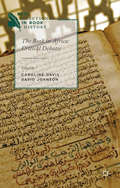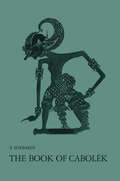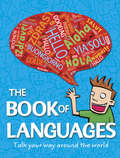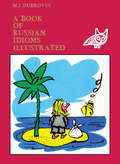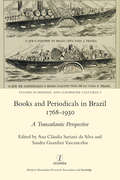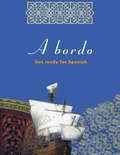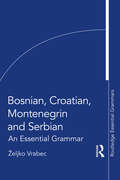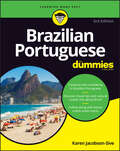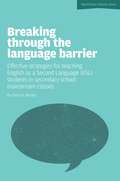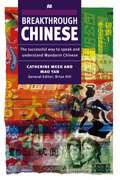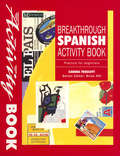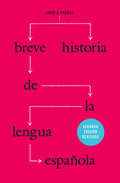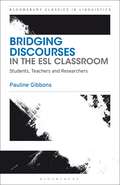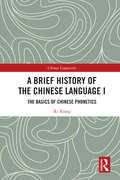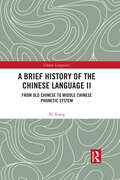- Table View
- List View
The Book in Africa: Critical Debates (New Directions in Book History)
by David Johnson Caroline DavisThis volume presents new research and critical debates in African book history, and brings together a range of disciplinary perspectives by leading scholars in the subject. It includes case studies from across Africa, ranging from third-century manuscript traditions to twenty-first century internet communications.
The Book of Cabolèk: A Critical Edition with Introduction, Translation and Notes. A Contribution to the study of the Javanese Mystical Tradition (Bibliotheca Indonesica #10)
by I. YasadipuraThe Scope of the Work The main purpose of this work is to give a critical edition of a Javanese text - the Serat Cabolek - together with an Introduction, an English trans lation of the text, and Notes. The present publication is a slighdy revised version of a doctoral dissertation submitted to the Australian National Univer sity in 1967. The Introduction to the text begins with a brief description of each of the extant MSS of the Serat Cabolek to be found in the Manuscript Sections of the Jakarta Museum Library and the Lembaga Kebudayaan Indonesia and in the Griental Manuscripts Section of the Leiden University Library. In addition, a description is given of a printed version of the Serat Cabolek. The eleven MSS and the printed text are compared with one another on the points of form, structure and content, in order to discover their mutual relationship. From this comparison it becomes clear that no matter how much these eleven MSS and the printed text of theSerat Cabolek may differ the one from the other, they all share a common core and all ultimately derive from a single source. The kernel of the Serat Cabolek in all probability comprised only the following sections: (1) the story dealing with the trial of Haji Mutamakin by the Kartasura tribunal; (2) the teaching of Dewa Ruci to Bhima; and (3) a commentary on Dewa Ruds counsel to Bhima.
The Book of Languages: Talk your way around the world
by Mick WebbDid you know that there are nearly 7,000 languages spoken around the world? This book introduces you to a wide variety of different languages to start you off on your language-learning journey.Find out where languages come from and where they are spoken. From Arabic to Zulu, Morse code to whale song, this book is packed with language facts and phrases to help you communicate all around the world. It includes: basic vocabulary and short dialogues to practise, maps and flags to show where languages are spoken and information on non-verbal languages, including sign language.
A Book of Russian Idioms Illustrated
by M. I. DubrovinA Book of Russian Idioms Illustrated highlights the role of Russian idioms in the historical development of the Russian language and how mastery of these idioms can bring about deeper understanding of the language. The book identifies the types of idioms that are discussed, and then states that phraseological fusions are word combinations whose meaning cannot be deduced from the meaning of their elements, while phraseological unities are word combinations whose meaning are partly dependent on the connotation of their individual words. The idioms are arranged alphabetically as units, and each entry is composed of a Russian idiom with its transliteration, literal translation, and explanation. English equivalents are also provided. The text underscores the use of pictures to depict the meaning of idioms and to illustrate their real meanings. The illustrations are presented in a humorous manner, showing the influence of humor in Russian idioms. The manuscript notes that Russian idioms are greatly of popular origin, hence they practically deal with human relations. The book is a vital reference for English speaking students of the Russian language who are familiar with the essentials of Russian grammar and basic Russian vocabulary.
Books and Periodicals in Brazil 1768-1930
by AnaClaudiaSurianiDa SilvaBefore the Portuguese Royal Court moved to its South-American colony in 1808, books and periodicals had a very limited circulation there. It was only when Brazilian ports were opened to foreign trade that the book trade began to flourish, and printed matter became more easily available to readers, whether for pleasure, for instruction or for political reasons. This book brings together a collection of original articles on the transnational relations between Brazil and Europe, especially England and France, in the domain of literature and print culture from its early stages to the end of the 1920s. It covers the time when it was forbidden to print in Brazil, and Portugal strictly controlled which books were sent to the colony, through the quick flourishing of a transnational printing industry and book market after 1822, to the shift of hegemony in the printing business from foreign to Brazilian hands at the beginning of the twentieth century. Sandra Guardini Vasconcelos is Professor of English and Comparative Literature at the University of Sao Paulo.
Books and Periodicals in Brazil 1768-1930
by AnaClaudiaSurianiDa SilvaBefore the Portuguese Royal Court moved to its South-American colony in 1808, books and periodicals had a very limited circulation there. It was only when Brazilian ports were opened to foreign trade that the book trade began to flourish, and printed matter became more easily available to readers, whether for pleasure, for instruction or for political reasons. This book brings together a collection of original articles on the transnational relations between Brazil and Europe, especially England and France, in the domain of literature and print culture from its early stages to the end of the 1920s. It covers the time when it was forbidden to print in Brazil, and Portugal strictly controlled which books were sent to the colony, through the quick flourishing of a transnational printing industry and book market after 1822, to the shift of hegemony in the printing business from foreign to Brazilian hands at the beginning of the twentieth century. Sandra Guardini Vasconcelos is Professor of English and Comparative Literature at the University of Sao Paulo.
A Bordo: Get Ready for Spanish
by Spanish Course TeamIdeal for near beginners, A bordo takes learners up to the equivalent of GCSE level Spanish. The course is accompanied by three audio-cassettes which include drama and dialogue. Features include:* focus on both Spanish and Latin-American culture* emphasis on communicating in everyday situations* varied exercises, with answer key and progress resumé at the end of each unit.A bordo is the preparatory course for En rumbo, also devised by the Open University Spanish team (see below).
A Bordo: Get Ready for Spanish
by Spanish Course TeamIdeal for near beginners, A bordo takes learners up to the equivalent of GCSE level Spanish. The course is accompanied by three audio-cassettes which include drama and dialogue. Features include:* focus on both Spanish and Latin-American culture* emphasis on communicating in everyday situations* varied exercises, with answer key and progress resumé at the end of each unit.A bordo is the preparatory course for En rumbo, also devised by the Open University Spanish team (see below).
Bosnian, Croatian, Montenegrin and Serbian: An Essential Grammar (Routledge Essential Grammars)
by Željko VrabecBosnian, Croatian, Montenegrin and Serbian: An Essential Grammar is intended for beginners and intermediate students who need a reference that explains grammar in straightforward terms. It covers all the main areas of the modern single BCMS grammatical system in an accessible way, and free from jargon. When linguistic terminology is used, it is explained in layman’s terms, the logic of a rule is presented simply and near parallels are drawn with English. This book covers all the grammar necessary for everyday communication (reaching B1 and B2 of the CEFR, ACTFL Intermediate-Intermediate- Mid). The book comprises of extensive chapters on all parts of speech, the creation of different word forms (endings for cases in nouns and adjectives, case forms for pronouns, tenses, verbal modes, verbal aspect etc.) and their uses in sentences. Each rule is illustrated with numerous examples from everyday living language used in Bosnia-Herzegovina, Croatia, Montenegro and Serbia. It is a unique reference book in English aimed at this level of language study that treats BCMS as a single grammar system, explaining and highlighting all the small differences between the four variants of this polycentric language.
Bosnian, Croatian, Montenegrin and Serbian: An Essential Grammar (Routledge Essential Grammars)
by Željko VrabecBosnian, Croatian, Montenegrin and Serbian: An Essential Grammar is intended for beginners and intermediate students who need a reference that explains grammar in straightforward terms. It covers all the main areas of the modern single BCMS grammatical system in an accessible way, and free from jargon. When linguistic terminology is used, it is explained in layman’s terms, the logic of a rule is presented simply and near parallels are drawn with English. This book covers all the grammar necessary for everyday communication (reaching B1 and B2 of the CEFR, ACTFL Intermediate-Intermediate- Mid). The book comprises of extensive chapters on all parts of speech, the creation of different word forms (endings for cases in nouns and adjectives, case forms for pronouns, tenses, verbal modes, verbal aspect etc.) and their uses in sentences. Each rule is illustrated with numerous examples from everyday living language used in Bosnia-Herzegovina, Croatia, Montenegro and Serbia. It is a unique reference book in English aimed at this level of language study that treats BCMS as a single grammar system, explaining and highlighting all the small differences between the four variants of this polycentric language.
Brazilian Portuguese For Dummies
by Karen Jacobson-SiveLanguage learning is easy with Dummies Brazilian Portuguese For Dummies can help you achieve your goals of learning another language. Traveling to Brazil? Taking a class in school? Want to meet people and pick up a new hobby? Just curious about the sixth most spoken language in the world? We&’ve got you covered, with easy-to-follow lessons on the basics, plus phrases and topics you need to know, like greetings, travel phrases, business phrases, numbers and measurements, and social media. Add speaking Portuguese to the long list of cool things you can do—with the help of Brazilian Portuguese For Dummies. Start from the beginning and learn the very basics of Brazilian Portuguese Practice authentic phrases for travel, business, and communicating online Perfect your pronunciation with bonus audio tracks, and discover fun facts about Brazilian culture Get recommendations for movies, travel tips, and moreWhether you&’re studying Portuguese for business, school, or pleasure, Dummies is the best guide for getting started with this beautiful language.
Brazilian Portuguese For Dummies
by Karen Jacobson-SiveLanguage learning is easy with Dummies Brazilian Portuguese For Dummies can help you achieve your goals of learning another language. Traveling to Brazil? Taking a class in school? Want to meet people and pick up a new hobby? Just curious about the sixth most spoken language in the world? We&’ve got you covered, with easy-to-follow lessons on the basics, plus phrases and topics you need to know, like greetings, travel phrases, business phrases, numbers and measurements, and social media. Add speaking Portuguese to the long list of cool things you can do—with the help of Brazilian Portuguese For Dummies. Start from the beginning and learn the very basics of Brazilian Portuguese Practice authentic phrases for travel, business, and communicating online Perfect your pronunciation with bonus audio tracks, and discover fun facts about Brazilian culture Get recommendations for movies, travel tips, and moreWhether you&’re studying Portuguese for business, school, or pleasure, Dummies is the best guide for getting started with this beautiful language.
Breaking Through the Language Barrier: Effective Strategies for Teaching English as a Second Language (ESL) to Secondary School Students in Mainstream Classes
by Patricia MertinTeaching students for whom English is not their first language is a huge challenge for any educator. It is frustrating and demoralising for teachers and their students if the language barrier prevents learning and progress in the classroom. But, with ever increasing numbers of English as a Second Language (ESL) students in secondary schools - there is now a majority in international schools - teachers need to know how to overcome common problems and teach ESL students effectively. This concise and informative book provides strategies and practical advice that teachers can use every day in the classroom to help ESL students understand and get to grips with their subject. It includes advice on using the textbook, cultural differences, realistic timescales for learning, and language and grammar that is easy to understand; plus chapters on teaching specific subjects. Patricia Mertin is Mother Tongue co-ordinator at the International School of Dusseldorf and has vast experience of teaching ESL students.
Breakthrough Chinese
by Catherine MeekA new approach to the teaching of Mandarin Chinese, this course concentrates on the essentials needed for everyday situations while travelling in China and provides a sound basis for further study. Based on authentic recordings made on location in Beijing, it exposes the learner to the genuine sound of the language, supported by carefully explained notes and scripted studio recordings with a wealth of practice activities. Unlike other Mandarin Chinese courses it focuses heavily on listening and speaking skills, backed up by simple, clear but short grammar explanations and exercises. One page in each of the fifteen units is devoted to providing fascinating background detail about China and the Chinese. Pinyin is used throughout rather than the Chinese characters.
Breve historia de la lengua española: Segunda edición revisada
by David A. PhariesPublicada inicialmente en 2007, esta Breve historia de la lengua española se ha convertido en la introducción más difundida a una de las lenguas más importantes del mundo por la extensión de su dominio y el número de hablantes. Este libro ofrece al lector un relato conciso que se propone profundizar en la evolución de la lengua desde sus raíces latinas hasta el presente, prestando especial atención a los cambios históricos y culturales que contribuyeron a su evolución y propagación por el mundo. La Breve historia de la lengua española se concentra en los cambios más importantes de la evolución de la lengua, evitando la jerga académica ininteligible y favoreciendo la claridad en las explicaciones. Por el camino, intenta dar respuesta a muchas de las preguntas que con frecuencia desconciertan a los hablantes nativos y no nativos: ¿Por qué se utiliza tú en algunos lugares y vos en otros? ¿Cómo surgió la pronunciación como fricativa interdental de la zeta castellana? ¿Por qué se dice la mesa pero el agua con un artículo que parece masculino? David A. Pharies es un experto en el estudio de la historia y evolución del español, que goza de un reconocido prestigio en la escena internacional. Para actualizar esta segunda edición ha revisado en profundidad todos los aspectos de la evolución del español, incluido su desarrollo demográfico. El libro va dirigido a quienes tienen un conocimiento básico del español y desean aprender más sobre sus orígenes. También constituye una base ideal para emprender el estudio de cualquier aspecto de la lingüística histórica española y de la literatura medieval. Entretenida y accesible, la Breve historia de la lengua española es un gran viaje de descubrimiento en una presentación amena y sucinta. Since its publication in 2007, A Brief History of the Spanish Language has become the leading introduction to the history of one of the world’s most widely spoken languages. Moving from the language’s Latin roots to its present-day forms, this concise book offers readers insights into the origin and evolution of Spanish, the historical and cultural changes that shaped it, and its spread around the world. A Brief History of the Spanish Language focuses on the most important aspects of the development of the Spanish language, eschewing technical jargon in favor of straightforward explanations. Along the way, it answers many of the common questions that puzzle native and nonnative speakers alike, such as: Why do some regions use tú while others use vos? How did the th sound develop in Castilian? And why is it la mesa but el agua? David A. Pharies, an internationally recognized expert on the history and development of Spanish, has updated this edition with new research on all aspects of the evolution of Spanish while adding current demographic information as well. This book is perfect for anyone with a basic understanding of Spanish and a desire to further explore its roots. It also provides an ideal foundation for further study in any area of historical Spanish linguistics and early Spanish literature. Both absorbing and accessible, A Brief History of the Spanish Language is a grand journey of discovery in a beautifully compact format.
Breve historia de la lengua española: Segunda edición revisada
by David A. PhariesPublicada inicialmente en 2007, esta Breve historia de la lengua española se ha convertido en la introducción más difundida a una de las lenguas más importantes del mundo por la extensión de su dominio y el número de hablantes. Este libro ofrece al lector un relato conciso que se propone profundizar en la evolución de la lengua desde sus raíces latinas hasta el presente, prestando especial atención a los cambios históricos y culturales que contribuyeron a su evolución y propagación por el mundo. La Breve historia de la lengua española se concentra en los cambios más importantes de la evolución de la lengua, evitando la jerga académica ininteligible y favoreciendo la claridad en las explicaciones. Por el camino, intenta dar respuesta a muchas de las preguntas que con frecuencia desconciertan a los hablantes nativos y no nativos: ¿Por qué se utiliza tú en algunos lugares y vos en otros? ¿Cómo surgió la pronunciación como fricativa interdental de la zeta castellana? ¿Por qué se dice la mesa pero el agua con un artículo que parece masculino? David A. Pharies es un experto en el estudio de la historia y evolución del español, que goza de un reconocido prestigio en la escena internacional. Para actualizar esta segunda edición ha revisado en profundidad todos los aspectos de la evolución del español, incluido su desarrollo demográfico. El libro va dirigido a quienes tienen un conocimiento básico del español y desean aprender más sobre sus orígenes. También constituye una base ideal para emprender el estudio de cualquier aspecto de la lingüística histórica española y de la literatura medieval. Entretenida y accesible, la Breve historia de la lengua española es un gran viaje de descubrimiento en una presentación amena y sucinta. Since its publication in 2007, A Brief History of the Spanish Language has become the leading introduction to the history of one of the world’s most widely spoken languages. Moving from the language’s Latin roots to its present-day forms, this concise book offers readers insights into the origin and evolution of Spanish, the historical and cultural changes that shaped it, and its spread around the world. A Brief History of the Spanish Language focuses on the most important aspects of the development of the Spanish language, eschewing technical jargon in favor of straightforward explanations. Along the way, it answers many of the common questions that puzzle native and nonnative speakers alike, such as: Why do some regions use tú while others use vos? How did the th sound develop in Castilian? And why is it la mesa but el agua? David A. Pharies, an internationally recognized expert on the history and development of Spanish, has updated this edition with new research on all aspects of the evolution of Spanish while adding current demographic information as well. This book is perfect for anyone with a basic understanding of Spanish and a desire to further explore its roots. It also provides an ideal foundation for further study in any area of historical Spanish linguistics and early Spanish literature. Both absorbing and accessible, A Brief History of the Spanish Language is a grand journey of discovery in a beautifully compact format.
Breve historia de la lengua española: Segunda edición revisada
by David A. PhariesPublicada inicialmente en 2007, esta Breve historia de la lengua española se ha convertido en la introducción más difundida a una de las lenguas más importantes del mundo por la extensión de su dominio y el número de hablantes. Este libro ofrece al lector un relato conciso que se propone profundizar en la evolución de la lengua desde sus raíces latinas hasta el presente, prestando especial atención a los cambios históricos y culturales que contribuyeron a su evolución y propagación por el mundo. La Breve historia de la lengua española se concentra en los cambios más importantes de la evolución de la lengua, evitando la jerga académica ininteligible y favoreciendo la claridad en las explicaciones. Por el camino, intenta dar respuesta a muchas de las preguntas que con frecuencia desconciertan a los hablantes nativos y no nativos: ¿Por qué se utiliza tú en algunos lugares y vos en otros? ¿Cómo surgió la pronunciación como fricativa interdental de la zeta castellana? ¿Por qué se dice la mesa pero el agua con un artículo que parece masculino? David A. Pharies es un experto en el estudio de la historia y evolución del español, que goza de un reconocido prestigio en la escena internacional. Para actualizar esta segunda edición ha revisado en profundidad todos los aspectos de la evolución del español, incluido su desarrollo demográfico. El libro va dirigido a quienes tienen un conocimiento básico del español y desean aprender más sobre sus orígenes. También constituye una base ideal para emprender el estudio de cualquier aspecto de la lingüística histórica española y de la literatura medieval. Entretenida y accesible, la Breve historia de la lengua española es un gran viaje de descubrimiento en una presentación amena y sucinta. Since its publication in 2007, A Brief History of the Spanish Language has become the leading introduction to the history of one of the world’s most widely spoken languages. Moving from the language’s Latin roots to its present-day forms, this concise book offers readers insights into the origin and evolution of Spanish, the historical and cultural changes that shaped it, and its spread around the world. A Brief History of the Spanish Language focuses on the most important aspects of the development of the Spanish language, eschewing technical jargon in favor of straightforward explanations. Along the way, it answers many of the common questions that puzzle native and nonnative speakers alike, such as: Why do some regions use tú while others use vos? How did the th sound develop in Castilian? And why is it la mesa but el agua? David A. Pharies, an internationally recognized expert on the history and development of Spanish, has updated this edition with new research on all aspects of the evolution of Spanish while adding current demographic information as well. This book is perfect for anyone with a basic understanding of Spanish and a desire to further explore its roots. It also provides an ideal foundation for further study in any area of historical Spanish linguistics and early Spanish literature. Both absorbing and accessible, A Brief History of the Spanish Language is a grand journey of discovery in a beautifully compact format.
Breve historia de la lengua española: Segunda edición revisada
by David A. PhariesPublicada inicialmente en 2007, esta Breve historia de la lengua española se ha convertido en la introducción más difundida a una de las lenguas más importantes del mundo por la extensión de su dominio y el número de hablantes. Este libro ofrece al lector un relato conciso que se propone profundizar en la evolución de la lengua desde sus raíces latinas hasta el presente, prestando especial atención a los cambios históricos y culturales que contribuyeron a su evolución y propagación por el mundo. La Breve historia de la lengua española se concentra en los cambios más importantes de la evolución de la lengua, evitando la jerga académica ininteligible y favoreciendo la claridad en las explicaciones. Por el camino, intenta dar respuesta a muchas de las preguntas que con frecuencia desconciertan a los hablantes nativos y no nativos: ¿Por qué se utiliza tú en algunos lugares y vos en otros? ¿Cómo surgió la pronunciación como fricativa interdental de la zeta castellana? ¿Por qué se dice la mesa pero el agua con un artículo que parece masculino? David A. Pharies es un experto en el estudio de la historia y evolución del español, que goza de un reconocido prestigio en la escena internacional. Para actualizar esta segunda edición ha revisado en profundidad todos los aspectos de la evolución del español, incluido su desarrollo demográfico. El libro va dirigido a quienes tienen un conocimiento básico del español y desean aprender más sobre sus orígenes. También constituye una base ideal para emprender el estudio de cualquier aspecto de la lingüística histórica española y de la literatura medieval. Entretenida y accesible, la Breve historia de la lengua española es un gran viaje de descubrimiento en una presentación amena y sucinta. Since its publication in 2007, A Brief History of the Spanish Language has become the leading introduction to the history of one of the world’s most widely spoken languages. Moving from the language’s Latin roots to its present-day forms, this concise book offers readers insights into the origin and evolution of Spanish, the historical and cultural changes that shaped it, and its spread around the world. A Brief History of the Spanish Language focuses on the most important aspects of the development of the Spanish language, eschewing technical jargon in favor of straightforward explanations. Along the way, it answers many of the common questions that puzzle native and nonnative speakers alike, such as: Why do some regions use tú while others use vos? How did the th sound develop in Castilian? And why is it la mesa but el agua? David A. Pharies, an internationally recognized expert on the history and development of Spanish, has updated this edition with new research on all aspects of the evolution of Spanish while adding current demographic information as well. This book is perfect for anyone with a basic understanding of Spanish and a desire to further explore its roots. It also provides an ideal foundation for further study in any area of historical Spanish linguistics and early Spanish literature. Both absorbing and accessible, A Brief History of the Spanish Language is a grand journey of discovery in a beautifully compact format.
Bridging Discourses in the ESL Classroom: Students, Teachers and Researchers (Bloomsbury Classics in Linguistics)
by Pauline GibbonsBridging Discourses in the ESL Classroom is concerned with the nature of talk in multilingual classrooms. Examining the interactions between students learning in and through English as a second language and their teachers, this book identifies the patterns of discourse which support and enable both second language development and the learning of curriculum knowledge. These patterns are 'bridging discourses', combining the everyday language used by the student with the specialised language of the academic register.Drawing on second language acquisition research and systemic functional linguistic theory, in particular the work of Halliday and Vygotsky, Pauline Gibbons develops tools to view classroom talk through a powerful interdisciplinary lens. Putting forward an innovative new theory of classroom discourse analysis, this book focuses on applying theory to practice. This is an invaluable resource for all teachers, researchers and students of linguistics and education.
Bridging Discourses in the ESL Classroom: Students, Teachers and Researchers (Bloomsbury Classics in Linguistics)
by Pauline GibbonsBridging Discourses in the ESL Classroom is concerned with the nature of talk in multilingual classrooms. Examining the interactions between students learning in and through English as a second language and their teachers, this book identifies the patterns of discourse which support and enable both second language development and the learning of curriculum knowledge. These patterns are 'bridging discourses', combining the everyday language used by the student with the specialised language of the academic register.Drawing on second language acquisition research and systemic functional linguistic theory, in particular the work of Halliday and Vygotsky, Pauline Gibbons develops tools to view classroom talk through a powerful interdisciplinary lens. Putting forward an innovative new theory of classroom discourse analysis, this book focuses on applying theory to practice. This is an invaluable resource for all teachers, researchers and students of linguistics and education.
A Brief History of the Chinese Language I: The Basics of Chinese Phonetics (Chinese Linguistics)
by Xi XiangAs the first volume of a multi-volume set on Chinese phonetics, this book gives a full picture of the historical development of the Chinese language and studies the phonetics of the early form of Chinese, i.e. Old Chinese.Chinese language history is generally split into three phases: 1) Old Chinese, the form of the Chinese language spoken between the 18th century BC and the 3rd century AD, 2) Middle Chinese, between the 4th century AD to around the 12th century AD, and 3) Modern Chinese, since the 13th century. In this volume, the author first introduces basic issues in Chinese language study, including research objectives, methodology, existing scholarship, periodization, and the distinctive linguistic characteristics of each period. The core chapters then describe and analyze the phonetical systems of Old Chinese, covering the initials system and related eight aspects, two types of rhyme groups, ancient finals, and the tonal system.This comprehensive groundwork on Chinese phonetical history will be a must read for scholars and students studying Chinese language, linguistics and especially for those wishing to become acquainted with Old Chinese phonetics.
A Brief History of the Chinese Language I: The Basics of Chinese Phonetics (Chinese Linguistics)
by Xi XiangAs the first volume of a multi-volume set on Chinese phonetics, this book gives a full picture of the historical development of the Chinese language and studies the phonetics of the early form of Chinese, i.e. Old Chinese.Chinese language history is generally split into three phases: 1) Old Chinese, the form of the Chinese language spoken between the 18th century BC and the 3rd century AD, 2) Middle Chinese, between the 4th century AD to around the 12th century AD, and 3) Modern Chinese, since the 13th century. In this volume, the author first introduces basic issues in Chinese language study, including research objectives, methodology, existing scholarship, periodization, and the distinctive linguistic characteristics of each period. The core chapters then describe and analyze the phonetical systems of Old Chinese, covering the initials system and related eight aspects, two types of rhyme groups, ancient finals, and the tonal system.This comprehensive groundwork on Chinese phonetical history will be a must read for scholars and students studying Chinese language, linguistics and especially for those wishing to become acquainted with Old Chinese phonetics.
A Brief History of the Chinese Language II: From Old Chinese to Middle Chinese Phonetic System (Chinese Linguistics)
by Xi XiangAs the second volume of a multi-volume set on Chinese phonetics, this book examines the phonetical systems of Middle Chinese and phonetical changes from Old Chinese to Middle Chinese.Chinese language history is generally split into three phases: 1) Old Chinese, the form of the Chinese language spoken between the 18th century BC and the 3rd century AD, 2) Middle Chinese, between the 4th century AD to around the 12th century AD, and 3) Modern Chinese, since the 13th century. This volume studies the phonological system of Middle Chinese, including the initials system, finals system, and tonal system, examining the evolution of these systems from the period of Old Chinese to that of Middle Chinese.This comprehensive groundwork on Chinese phonetical history will be a must read for scholars and student studying Chinese language, linguistics and especially for beginning learners of Middle Chinese phonetics.
A Brief History of the Chinese Language II: From Old Chinese to Middle Chinese Phonetic System (Chinese Linguistics)
by Xi XiangAs the second volume of a multi-volume set on Chinese phonetics, this book examines the phonetical systems of Middle Chinese and phonetical changes from Old Chinese to Middle Chinese.Chinese language history is generally split into three phases: 1) Old Chinese, the form of the Chinese language spoken between the 18th century BC and the 3rd century AD, 2) Middle Chinese, between the 4th century AD to around the 12th century AD, and 3) Modern Chinese, since the 13th century. This volume studies the phonological system of Middle Chinese, including the initials system, finals system, and tonal system, examining the evolution of these systems from the period of Old Chinese to that of Middle Chinese.This comprehensive groundwork on Chinese phonetical history will be a must read for scholars and student studying Chinese language, linguistics and especially for beginning learners of Middle Chinese phonetics.
